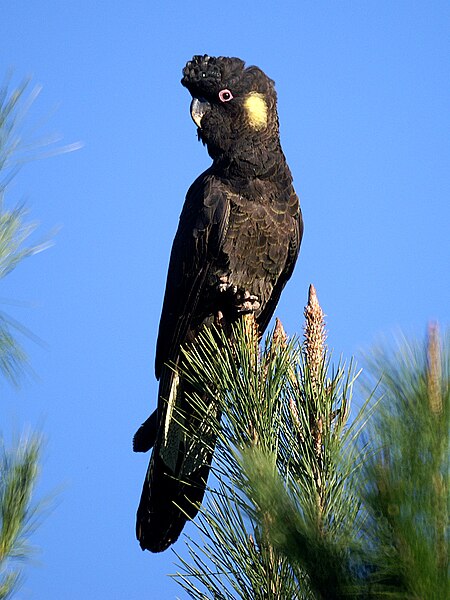 Although a total population of 25 individuals does not sound very promising, hope remains that the Eyre Peninsula population of Yellow-Tailed Black Cockatoos (Calyptorhynchus funereus xanthanotus) will rebound. With only 9 birds believed left in the wild, even the hatching of single chick, the first since the devastating brush fires of January, 2005, is cause for celebration. A second chick, hatched at the George Wildlife Park in Adelaide, brought the captive population to 15.
Although a total population of 25 individuals does not sound very promising, hope remains that the Eyre Peninsula population of Yellow-Tailed Black Cockatoos (Calyptorhynchus funereus xanthanotus) will rebound. With only 9 birds believed left in the wild, even the hatching of single chick, the first since the devastating brush fires of January, 2005, is cause for celebration. A second chick, hatched at the George Wildlife Park in Adelaide, brought the captive population to 15.
Fires Deliver the Knockout Punch
While this species does range into other parts of Australia, the isolated population inhabiting South Australia’s Eyre Peninsula has long been at risk of extinction. The massive fires of 2005 pushed them further towards the brink, destroying breeding habitat and depressing food supplies.
The Yellow-Tailed Black Cockatoo is unique among parrots in feeding heavily upon beetle grubs and moth larvae, which had been in short supply until heavy rains arrived earlier this year. Also, in common with other cockatoos, they are cavity nesters and cannot utilize alternative sites – many nesting trees were lost during the fires.
Cautious Optimism
Australian wildlife biologists monitoring the wild population believe that the rains, insect abundance and successful nesting may be a sign of good things to come. The birds were also observed consuming Hakea seeds and other foods that had been planted for them as part of the government’s rescue effort. The fact that it took 5 years for a single chick to be produced, however, highlights just how uncertain this population’s future is.
 The captive birth at the George Wildlife Park is also promising, as the parents were young birds that had not previously reproduced. Four other pairs now kept at the park will hopefully “pitch in” to boost the population as well.
The captive birth at the George Wildlife Park is also promising, as the parents were young birds that had not previously reproduced. Four other pairs now kept at the park will hopefully “pitch in” to boost the population as well.
This project illustrates well the fact that even small-scale recovery plans can be important to cockatoos and other birds that face threats to their survival.
Further Reading
Please see The Natural History of Black, Red-Tailed and Glossy Cockatoos for info more on these interesting Psittacines.
Video of wild Yellow-Tailed Black Cockatoos foraging for grubs.
Yellow-tailed Black Cockatoo Male image referenced from wikipedia and originally posted by David Cook Wildlife Photography
Yellow-tailed Black Cockatoo eating image referenced from wikipedia and originally Jonathan Zawada and posted by Snowmanradio
 That Bird Blog – Bird Care and History for Pet Birds
That Bird Blog – Bird Care and History for Pet Birds




Hello Frank, Do you have anything on Peafowl?
Because I’m taking care of a baby peachick of my
peafowls. Thank you for your time.
Hello Linda, Frank Indiviglio here.
Nice to hear from you, thanks for checking in.
Please let me know what type of info you need, and some details (age, etc). They are generally quite hardy, I’ve even seen them raised by turkey hens that were free ranging at the Bronx Zoo. They do need to walk quite a bit, to encourage normal leg development; splay-leg can be a concern early-on also.
Best regards, Frank Indiviglio.
In my opinion, the conservationists have done an excellent job and they deserve a pat on the back.
Hello Bryan, Frank Indiviglio here.
Thanks for your interest in our blog. I agree; I’ve seen examples of birds being brought back from such low levels (thinking here of zoo-based captive breeding programs I’ve worked on, Tahitian Lories, Calif. Condors, etc.), so the effort is very worthwhile.
Good luck and please keep me posted.
Best regards, Frank Indiviglio.